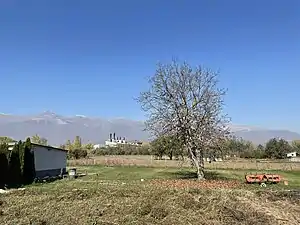 | |
Native name | Хемиско-електрометалуршки комбинат „Југохром“ |
|---|---|
| Type | state-owned enterprise privatised in 2000 |
| Industry | chemical, metallurgy |
| Founded | 1952 |
| Defunct | November 2016 |
| Fate | Closed |
| Headquarters | Јеgunovce, , Маcedonia |
| Products | ferrochrome, ferrosilicon, silicochrome, technical silicon, ferromanganese |
Chemico-Electrometallurgical Combine "Jugokrom" (abbreviated and commonly known as "Jugokrom"; Macedonian: Хемиско-електрометалуршки комбинат „Југохром“, ХЕК „Југохром“) was one of the largest combines in the industry of Macedonia. During the period of 1985–1988, it had approximately 7,000 employees,[1] and prior to its closure in November 2016, it had around 1,000 employees.
It was first privatised in the year 2000 when it operated under the name Silmak, and later changed ownership multiple times.
The main challenges faced by the combine were the supply of electricity and environmental issues. The combine was closed in November 2016 due to non-compliance with environmental permit requirements.[2]
History
The combine was established by the decision of the Government of the Socialist Republic of Macedonia in 1952 as the Factory for Chrome Products and Ferroalloys (Фабрика за хромни производи и феролегури), with the aim of exploiting the chromium ore from the Ljuboten serpentinite massif using electricity from the newly constructed Mavrovo Hydropower System.[1]
Construction began in 1953, and production started in 1957 with the construction of four electric arc smelting furnaces, although the production of chromium salts had already begun in the "Chemistry" department in 1950.[1]
In the period from 1960 to 1965, the production of calcium carbide and calcium cyanamide began.[1]
The combine continued to be built and expanded until the 1990s when production began to be discontinued in several departments, and some of them were separated and operated as independent units.[1]
After several transformations, in 2000, it continued to operate successfully under the name Silmak with dominant foreign ownership.[1]
The main challenge for the combine was the supply of electricity, which was consistently deficient and expensive, and the production of ferroalloys in electric smelting furnaces was one of the largest consumers of electricity.[1]
Departments
The main departments and products were:[1]
- Electrometallurgy (since 1957)
- Ferrochrome, ferrosilicon, silicochrome, technical silicon, ferromanganese, and others, all with various concentrations and qualities in terms of carbon content.
- Chemistry (since 1950)
- Bichromate and others.
- Raduša Mines and Chromite Separation
- "Non-Metals" from Tetovo (since 1955)
- "Stogovo" from Kičevo (since 1975)
- Industry for Construction Elements "Vratnica" (since 1976)
- Medical Plastics from Tetovo (since 1982)
Within the complex of the combine, there was also the railway station "Jegunovce Factory" (Јегуновце Фабрика), which is still regularly operated as part of the Skopje–Kičevo line.
Facilities
The "Jugokrom" Combine built hotels such as "Slavija" and "Popova Šapka" in the ski center of Popova Šapka, the hotel "Neda" in Galičnik, the hotel "Riviera" in Ohrid, and others.[2]
Ecology
The production of chromium salts has been discontinued due to the harmful effects of hexavalent chromium, which still poses a threat to water pollution in the area of Mount Žeden, where the Rašče Spring originates.[1] In 2020, a plan was presented for the cleanup of the landfill where there are waste materials containing hexavalent chromium, but due to legal obstacles, its implementation has not yet begun.[3]
Gallery
 Entrance to the plant
Entrance to the plant "Makpetrol" gas station at the entrance
"Makpetrol" gas station at the entrance
References
- 1 2 3 4 5 6 7 8 9 Ristovski, Blaže, ed. (2009). "„Јужна Стварност"". Macedonian Encyclopedia. Vol. book I (A-L). Skopje: МАNU. p. 651.
- 1 2 НМ (2019-07-19). "За проблемот "Југохром" и за општината Јегуновце". Нова Македонија. Retrieved 2022-02-10.
- ↑ "Законот ги спречува да го исчистат токсичниот отпад од "Југохром"". Радио Слободна Европа (in Macedonian). 9 June 2021. Retrieved 2022-02-10.